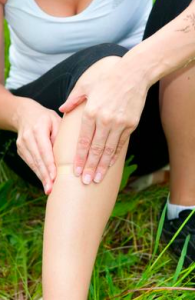What causes a medial collateral ligament injury?
 MCL injuries occur as a result of stretching and stressing the ligament past the point that it can safely handle. Often this results from excessive force to the outside of the knee (valgus force) and various twisting motions at the legs and knees. Examples include:
MCL injuries occur as a result of stretching and stressing the ligament past the point that it can safely handle. Often this results from excessive force to the outside of the knee (valgus force) and various twisting motions at the legs and knees. Examples include:
- Trauma/impact to the outside of the knee, such as getting hit with a ball or from a tackle
- Sudden changes in direction, especially during fast-paced activities
- Sharp twists at the knee while the foot is fixed on the ground
What are the symptoms?
The different levels of severity of injury include a ligament sprain, a partial tear, or a complete rupture. Symptoms can include:- Pain and tenderness at the inner knee
- Swelling
- Bruising
- A ‘snapping’ or ‘popping’ sound as the injury occurs
- Feeling unstable, like the knee is giving way
- Difficulty walking on the affected leg
- Catching at the knee joint








